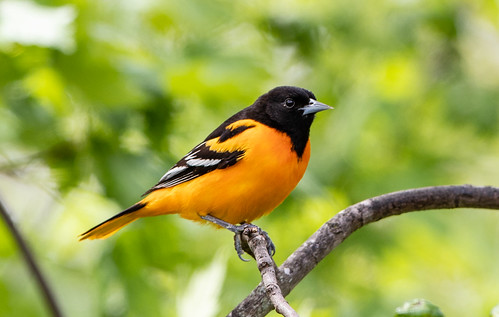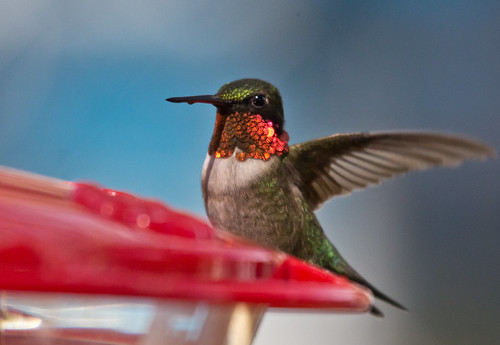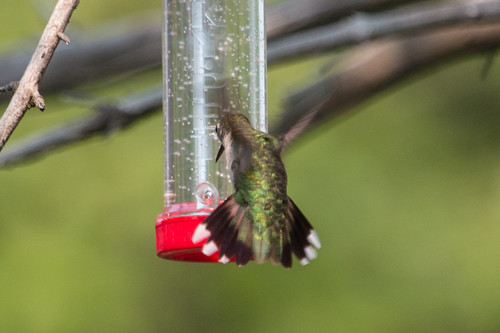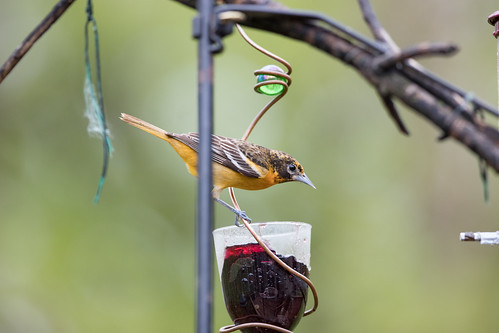Of all the months of the year, May is my favorite. From start to finish, May is filled with newness—baby birds of many non-migrating species hatch in May, and new migrating birds arrive every day. I saw many of my all-time favorite birds for the very first time in May 1975, starting with my first May lifer of all, the Red-headed Woodpecker. As the month progressed, I added lots of new birds, with Brown Thrasher, Baltimore Oriole, Gray Catbird, and Veery standing out, along with my first warblers ever.
The miracle of May is that all these splendid migrants are as predictable as the tides, yet every year, that first oriole, that first hummingbird, that first Brown Thrasher, that first warbler—every one of them seems as wonderful and exciting as it did way back when I saw them the very first time. How can anything so regular, ordinary, routine, normal be so wondrous—so literally awesome? It’s a miracle.
This year I’m about as well-prepared for May as I’ve ever been. I haven’t set my hummingbird feeders out yet, but they’re clean and ready. Some people have been posting sad photos of dead hummingbirds with their tongues sticking out to remind people to keep their feeders clean and to offer nothing except granulated sugar and water. Using honey or raw sugar is not good for hummers—bacteria or fungi grow more quickly using those—and red food dyes are harmful, too. Any commercial hummingbird nectar that is red is bad for them—it’s cheaper for us and healthier for the birds to use table sugar.
As a general rule, use ¼ cup of sugar per cup of water. During cold, wet conditions, you can make it a little stronger, up to about 1/3 cup of sugar per cup of water. Those are both within the range of the normal concentration of sugars in flower nectar. Don’t make sugar water stronger than that—hummingbirds need enough water to metabolize the sugar in their diets. A third of a cup of sugar per cup of water is plenty.
If you make large batches, it’s not a bad idea to boil the water, but it’s normally unnecessary. Just don’t let sugar water sit for a few days before using unless you refrigerate it. That’s to keep it from starting the fermentation process. When you buy hummingbird feeders, the most important feature to look for is that they’re easy to clean. You can wash them in the dishwasher or using liquid dish detergent, but always make sure you rinse them very thoroughly.
It’s wiser to use several small hummingbird feeders than a single large one—they don’t like to share, so will get the most benefit from your feeders if they don’t spend most of their time chasing or being chased by other hummingbirds.
And make sure you keep the feeders clean. During cold weather, they can stay out for three or four days, but during hot weather make sure you're rinsing them out with hot water and changing the water every day or two. If the water gets cloudy, you’ve waited too long. And scrub any scum from the crevices of the feeder with a bottle brush with every cleaning.
All that said, those internet memes showing photos of dead hummingbirds are almost certainly not showing birds that died from poor feeder practices. Birds’ tongues often stick out when they die, especially when they collide with a window or other structure. And hummingbirds spend a lot of their loafing time sticking their tongues in and out to keep them from getting sticky, whether they're eating natural nectar or sugar water. Using a dramatic photo in a misleading way does not strengthen one’s case.
A couple days ago, I put out one small oriole feeder for my first Brown Thrashers—I haven’t seen or heard any yet, but I want my first arrival to feel welcome. If you set out grape jelly for birds, make sure to only set out small plops at a time. It’s much better to use jelly with real sugar rather than high fructose corn syrup, and never ever use one with any artificial sweeteners. Oranges and grapes are much more nutritious than jelly, so make sure you offer some of those, too.
The next two weeks will see wondrous changes at our bird feeders. It takes a bit of work to welcome our birds back during their long journey from the tropics, but it’s worth it. It’s May!









